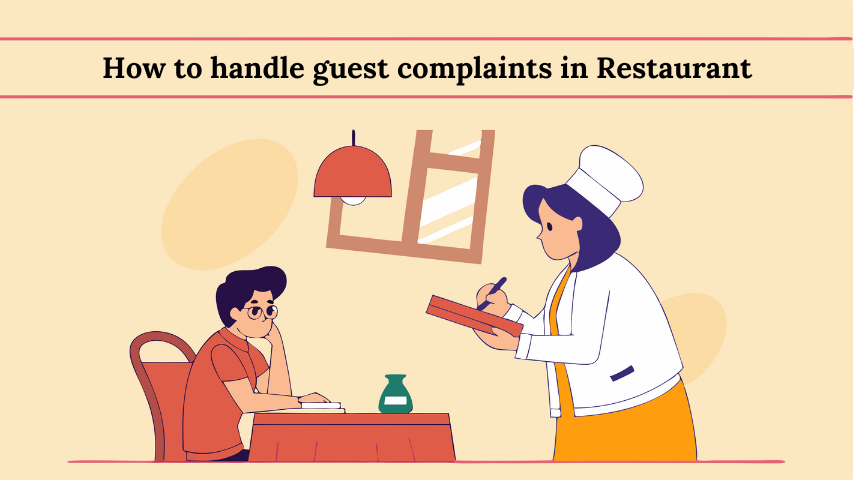How handle restaurant customer complaints?

In the dynamic world of restaurant management, knowing how to handle guest complaints in restaurant effectively can make the difference between losing customers and turning them into loyal patrons. This comprehensive guide explores proven strategies and best practices for managing customer complaints while maintaining professionalism and improving your restaurant’s reputation.
Understanding the Importance of Complaint Management
Restaurant complaints are inevitable, but they present valuable opportunities for improvement and customer relationship building. When handled properly, complaints can:
- Build stronger customer relationships
- Identify areas for service improvement
- Enhance staff training programs
- Boost customer loyalty and retention
- Protect and improve your restaurant’s reputation
Common Types of Restaurant Complaints
Understanding the most frequent complaints helps prepare your staff to handle them effectively:
Food-Related Issues
- Temperature problems (food too cold or hot)
- Incorrect preparation or cooking
- Food quality concerns
- Missing ingredients or modifications
- Portion size dissatisfaction
Service-Related Complaints
- Long wait times
- Inattentive staff
- Incorrect orders
- Poor communication
- Unfriendly service
Environmental Concerns
- Cleanliness issues
- Noise levels
- Temperature comfort
- Seating arrangements
- Restaurant ambiance
Essential Steps to Handle Guest Complaints in Restaurants
1. Listen Actively and Show Empathy
The first step in handling any complaint is to listen carefully to the customer’s concerns. This involves:
- Maintaining eye contact
- Avoiding interruptions
- Taking notes if necessary
- Showing genuine concern through body language
- Acknowledging their feelings without becoming defensive
2. Apologize Sincerely
A genuine apology goes a long way in diffusing tense situations:
- Express sincere regret for their negative experience
- Take responsibility without making excuses
- Use phrases like “I apologize for this inconvenience” or “I’m sorry you had this experience”
3. Act Quickly and Decisively
Prompt action shows customers you value their satisfaction:
- Address the issue immediately when possible
- Communicate clear timelines if immediate resolution isn’t possible
- Keep the customer informed of progress
- Follow through on promised actions
4. Offer Appropriate Solutions
Different situations require different remedies:
- Remake dishes that don’t meet expectations
- Offer complimentary items or discounts when appropriate
- Provide alternative seating options if available
- Consider future-date vouchers for serious issues
5. Follow Up and Document
After resolving the immediate concern:
- Check back with the customer to ensure satisfaction
- Document the complaint and resolution for future reference
- Review incidents with staff for training purposes
- Implement changes to prevent similar issues
Training Staff to Handle Complaints Effectively
Create Clear Guidelines
Develop a standardized approach for handling complaints:
- Establish a clear chain of command
- Define escalation procedures
- Create response templates for common situations
- Set guidelines for compensation or remediation
Emphasize Communication Skills
Train staff in essential communication techniques:
- Professional language and tone
- Active listening skills
- Conflict de-escalation methods
- Non-verbal communication awareness
- Proper documentation procedures
Regular Training Sessions
Maintain high service standards through:
- Role-playing exercises
- Case study reviews
- Customer service workshops
- Team feedback sessions
- Performance evaluations
Preventing Common Complaints
Quality Control Measures
Implement systems to maintain consistent quality:
- Regular food taste tests
- Temperature monitoring
- Portion size standards
- Cleanliness checklists
- Service timing metrics
Staff Empowerment
Enable staff to resolve issues independently:
- Provide authority to make decisions
- Set clear boundaries for compensation
- Encourage initiative in problem-solving
- Recognize excellent complaint handling
Leveraging Technology for Complaint Management
Digital Solutions
Utilize modern tools to track and manage complaints:
- Customer feedback systems
- Digital complaint logging
- Analytics for identifying patterns
- Communication platforms for staff
- Social media monitoring tools
Frequently Asked Questions
How should I handle aggressive or unreasonable customers?
Remain calm and professional while:
- Maintaining a safe distance
- Speaking in a steady, controlled voice
- Focusing on solutions rather than emotions
- Involving management when necessary
- Documenting all interactions
What’s the best way to handle complaints on social media?
Address social media complaints by:
- Responding promptly and professionally
- Moving discussions to private channels
- Offering specific solutions
- Following up publicly when resolved
- Monitoring mention and reviews regularly
How can I turn complainers into loyal customers?
Transform negative experiences by:
- Exceeding expectations in problem resolution
- Providing personalized follow-up
- Offering special incentives for return visits
- Demonstrating genuine care and concern
- Building lasting relationships through exceptional service
When should managers get involved in customer complaints?
Escalate to management when:
- The complaint is serious or complex
- Staff feels uncomfortable or threatened
- Standard solutions aren’t satisfying the customer
- The situation could affect other guests
- The complaint involves significant compensation
Measuring Success in Complaint Management
Key Performance Indicators
Track important metrics such as:
- Resolution time
- Customer satisfaction scores
- Return customer rates
- Complaint frequency
- Staff handling effectiveness
Feedback Analysis
Regularly review complaint data to:
- Identify common issues
- Develop preventive measures
- Improve training programs
- Adjust operational procedures
- Enhance customer experience
Conclusion
Learning how to handle guest complaints in restaurant effectively is crucial for long-term success in the hospitality industry. By implementing these strategies and maintaining a customer-centric approach, restaurants can turn challenging situations into opportunities for improvement and customer loyalty building.
Remember that every complaint represents a chance to demonstrate your commitment to customer satisfaction. Through proper training, clear procedures, and genuine care for guest experience, restaurants can build a reputation for excellence in service recovery and customer care.
Success in complaint management isn’t just about solving problems – it’s about creating positive experiences that encourage customers to return and recommend your establishment to others. By following these guidelines and continuously improving your approach to handling complaints, your restaurant can maintain high standards of service and build a loyal customer base.



